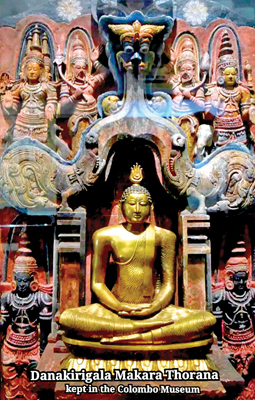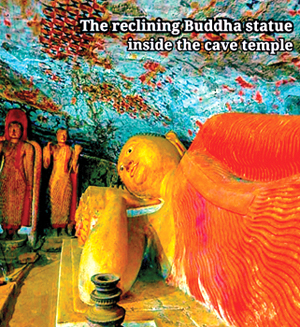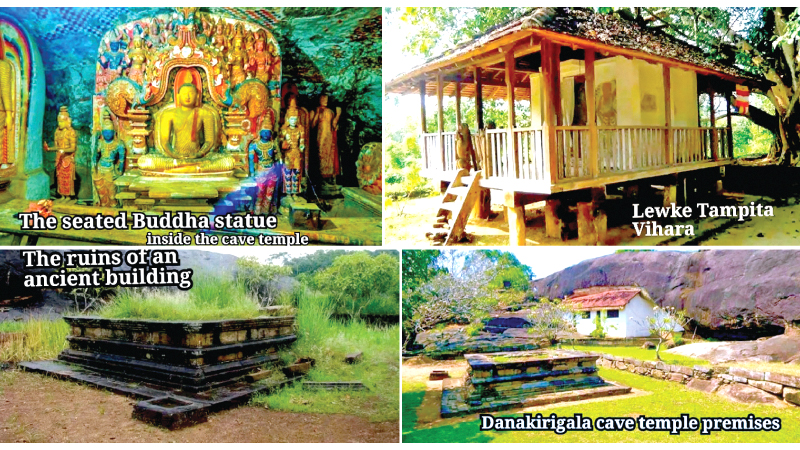Although King Kirthi Sri Rajasinghe, who reigned in Kandy from 1747 AD to 1782 AD, belonged to the Nayakkar dynasty, he offered great patronage to Buddhism. During his monarchy, the lost higher ordination was brought back from Siam and established here. Many derelict temples which had fallen into decay and neglect were revamped under his leadership and lands and villages were also offered for the perpetuation of the Buddhasasana. Danakirigala Rajamaha Vihara is one such Buddhist place of worship.
This beautiful sacred site is on a hill 9km West of the Ussapitiya junction on the Mawanella – Aranayaka road at Pattagama near Mawanella in the Kegalle district of the Sabaragamuwa Province.
 There is no dearth of evidence in the form of stone inscriptions that this region has been inhabited since the pre-Christian era and that there have always been Buddhist religious and cultural activities in the area. The inscriptions are mainly found in the Danakirigala temple premises and at several other places such as Hunuwala temple, Mampita, Karandulena, Alulena, Yatahalena, Ambalakanda, Padiyagampola, Helapitalena and Salgala.
There is no dearth of evidence in the form of stone inscriptions that this region has been inhabited since the pre-Christian era and that there have always been Buddhist religious and cultural activities in the area. The inscriptions are mainly found in the Danakirigala temple premises and at several other places such as Hunuwala temple, Mampita, Karandulena, Alulena, Yatahalena, Ambalakanda, Padiyagampola, Helapitalena and Salgala.
As regards the restoration of the temple, one can’t help but mention about Levke Wijesundara Bandara (1740-1751), an illustrious Buddhist who hailed from the Levke family who ruled the Hathara Korale during the period of the Kandyan Kingdom. He lived in a nearby village known as Galathara. It is he who built the steps made of granite up to the top of the Danakirigala rock. According to folktales, he built this flight of steps leading to the cave temple premises by bringing stone slabs every day from the Maoya on his way back home having bathed in the river. After climbing the steps, one can enter the cave temple courtyard. The cave temple carved out of the rock had first been offered to the Sangha in the pre-Christian era. During the Kandyan Kingdom, it was restored and again offered to the bhikkhus for the second time. The inscription set up at the cave reveals its historicity.
Hidden caves
The inscription says “Parumaka wesha putha parumaka weshaha lene”. It is translated in English as “The cave of chief Wesa, the son of a chief named Wesa”. There are three more caves hidden in the nearby thicket. In one of them is another pre-Brahmi cave inscription with pre-Brahmi words “Parumaka nadaka lene” engraved and it reads in English as the cave of chief Nanda”.
 The main cave temple with carved out drip-ledges is 100 feet long and 54 feet wide. It is 11 feet in height. Though the Danakirigala cave temple is small, the statues and murals in it are considered valuable works of art belonging to the Kandyan era. The features of a Kandyan era cave temple are well preserved here. Jathaka stories or events of the Buddha’s life are painted on the well-plastered and polished walls made of wattle and daub. This can presumably be thought of as an art gallery which houses extraordinary Buddhist masterpieces depicting the artistic expertise of the artists of the Kandyan era.
The main cave temple with carved out drip-ledges is 100 feet long and 54 feet wide. It is 11 feet in height. Though the Danakirigala cave temple is small, the statues and murals in it are considered valuable works of art belonging to the Kandyan era. The features of a Kandyan era cave temple are well preserved here. Jathaka stories or events of the Buddha’s life are painted on the well-plastered and polished walls made of wattle and daub. This can presumably be thought of as an art gallery which houses extraordinary Buddhist masterpieces depicting the artistic expertise of the artists of the Kandyan era.
The paintings and sculptures here were created by Ven. Devaragampala Thera who was an excellent painter during the reign of king Kirthi Sri Rajasinghe. He was engaged in the restoration of temples at the request of the King. The temples such as Degaldoruwa, Ridi Vihara, Danakirigala, Kaballalena, Wakirigala, which were beautified by the tender hands of Ven. Devaragampola Thera, still bear witness to his artistic skills.
Buddha statues
In the cave temple are three seated Buddha statues and six standing Buddha statues. A reclining Buddha statue is on the right facing the front wall of the temple. An eight foot tall statue of Levke Disava can also be seen here. The magnificent wooden dragon arch in the temple was stolen a few years ago, but later recovered and kept in the National Museum, Colombo for public display.
Right in front of the cave temple is a Bodhigara, which is made of polished granite blocks. It is rectangular in shape and 14 feet in length and width. To the left of the cave, the footprint of the Buddha is inscribed on the rock.
Levke Disava, who lived at Galathara, had built his mansion (walawwa) just one kilometre away from the temple. The walawwa has now collapsed. There is an ancient Tampita temple in front of the walawwa. This was their personal Buddha image house in which they worshipped. It is an archaeological monument today.
This historically significant temple, which was also renovated by king Rajadhirajasinghe (1781 AD- 1798 AD) later, is a unique place where we can see the best murals, motifs and sculptures, especially in the Kegalle District.









